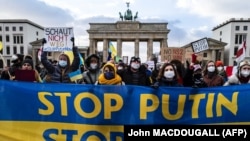On January 31, the United Nations Security Council held a special meeting on the situation in Ukraine requested by the United States. Russia objected to proceeding with the meeting but lost a vote to stop it. (China voted with Russia.)
The U.S. and its allies warned the U.N. that Russia’s military buildup around Ukraine posed a risk to peace and security. “The situation we are facing in Europe is urgent and dangerous. Russia’s actions strike at the very heart of the U.N. charter,” U.S. Ambassador to the U.N. Linda Thomas Greenfield said in her opening remarks.
Russia’s U.N. representative, Vasily Nebenzya, responded with denials, deriding the Security Council meeting as “megaphone diplomacy,” Russia’s state-owned broadcaster RT reported.
“Their (Western colleagues’ - RT) task is to prevent the natural, fraternal coexistence of our two countries [Russia and Ukraine] and peoples, which would destroy plans to weaken Russia and form an arc of instability around her,” Nebenzya said, apparently to NATO.
Russia is insisting that Ukraine be banned from NATO membership and citing security concerns to justify the buildup. Nebenzya left the meeting right before his Ukrainian counterpart took the microphone, RT reported.
In fact, nobody but Russia has been preventing “natural, fraternal coexistence” with its neighbors. Russia’s military aggression caused its alienation from Georgia in 2008 and Ukraine in 2014.
Nebenzya also cast doubt on the size of the military buildup near Ukrainian borders:
“Where did the figure of 100,000 troops, who are located, as you claim, on the Russian-Ukrainian border, come from? Although this is not the case – we have not mentioned or confirmed this figure anywhere.”
That is false. Of course, there isn’t an exact count, but satellite images document the buildup and Russia hasn't denied the troop movements.
The satellite imagery company Maxar Technologies first reported a significant increase of Russian troops and military equipment near Russia’s border with Ukraine back in November 2021. Images released by Maxar and shared by the news agencies showed an estimated 90,000 troops and military equipment near the city of Elnya, 250 km from Ukraine.
The buildup continued despite an offer by the United States and its European allies to negotiate de-escalation with the Kremlin. U.S. President Joe Biden spoke with Russian counterpart Vladimir Putin, warning of unprecedented sanctions should Russia forces cross into Ukraine.
Russia argues that it is being encircled by NATO’s gradual expansion. The Kremlin produced a set of security demands, including the withdrawal of NATO troops from Bulgaria and Romania, both of which are NATO member states. The U.S. and NATO have called withdrawals and the ban on Ukraine NATO membership non-starters.
The Kremlin and Russian Foreign Ministry have repeatedly denied plans to invade. Meanwhile, Russia’s Defense Ministry said it was conducting drills in southwestern Russia to test combat readiness.
Then, on January 29, Russia’s Defense Ministry announced that troops in the “Western Military District,” which directly borders Ukraine, would return to their permanent bases. The ministry said that “the advance parties of chemical, biological and nuclear defense units,” along with military aviation and tank brigades, had completed their exercises.
Military experts, including Michael Kofman, senior fellow at the Center for New American Security (CNAS), urged caution.
“It is not a positive indicator; quite the opposite. They're completing scheduled checks & training exercises, getting personnel to a higher level of readiness. There is no pullback of forward deployed units,” Kofman tweeted.
A new set of images released by Maxar on January 20 showed even more Russia troops and equipment in border areas, with the closest locations mapped as eight miles from Klimovo and about 18 miles from Klintsy (both Russian towns).
On January 25, the Russian investigative group Cite Intelligence Team said it had gathered evidence that Russia was relocating an elite airborne paratrooper unit to the Ukrainian border.
On January 28, Reuters, citing U.S. officials, reported that Russia’s buildup included blood supplies for potential casualties.
The White House said the U.S. would consider sending additional troops to assist NATO allies in Europe, as well as increase military aid to help Kyiv defend the country should Russia invade.
In addition, a senior White House official said on January 31 that Washington is ready to respond with a new round of sanctions that would target people “in or near the inner circles of the Kremlin and play a role in government decision-making or are at a minimum complicit in the Kremlin’s destabilizing behavior.”
Also on January 31, Putin ordered Russia’s social services agencies to pay benefits and pensions to the residents of Ukraine’s Donbas region, including those who do not have proof of Russian citizenship.
Simultaneously, the State Duma, the lower house of Russia’s parliament, discussed legislation calling on Putin to recognize Ukraine’s Donetsk and Luhansk regions as independent sovereign states. A vote on the bill reportedly is scheduled for February 14.





